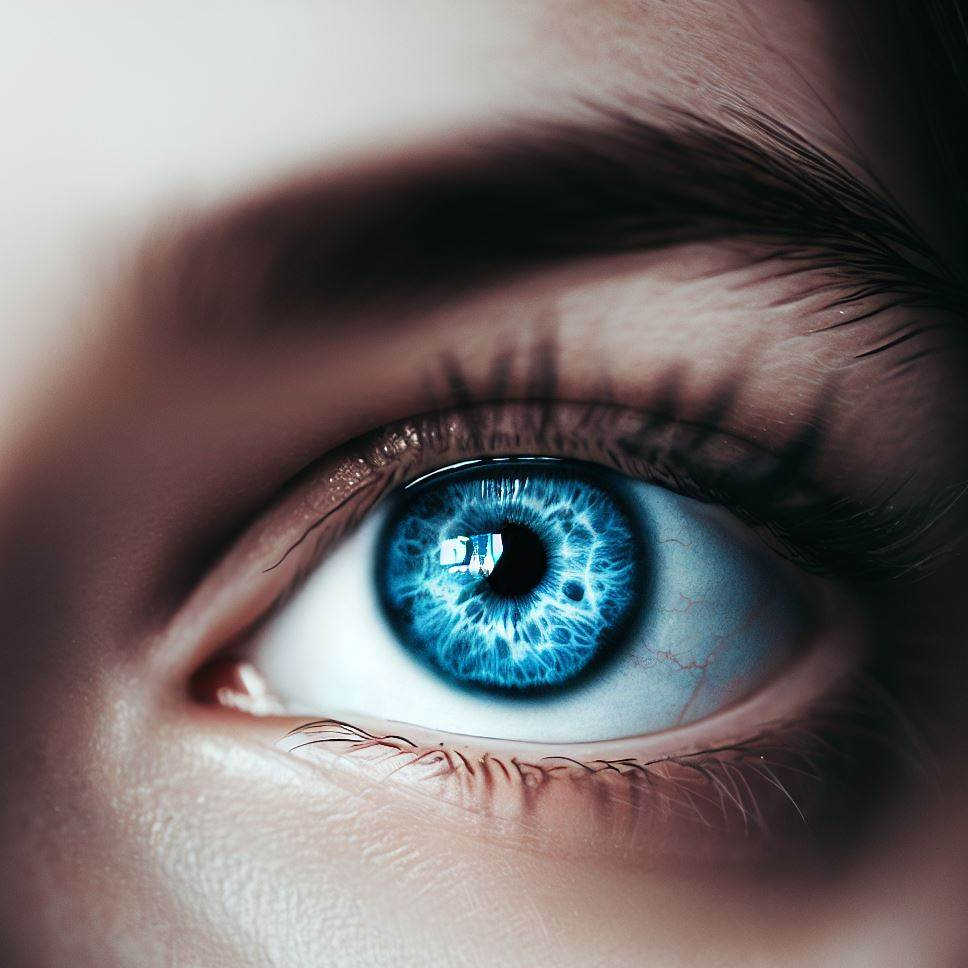The mesmerizing variety of eye colors observed in humans has long captivated our curiosity. From deep browns to vibrant greens and captivating blues, eye color is an intricate and fascinating trait. In this blog, we will delve into the science behind the different colors of human eyes, exploring the role of genetics, melanin pigments, and other contributing factors. Additionally we have added a table for "Eye Color Probability and Contributing Factors" at the end of article.
The Role of Melanin:
The key determinant of eye color lies in the iris, the colored part of the eye. Melanin, a pigment produced by specialized cells called melanocytes, plays a crucial role in determining eye color. There are two main types of melanin: eumelanin and pheomelanin.
-
Eumelanin: This dark brown to black pigment is responsible for the intensity of eye color. Higher concentrations of eumelanin result in darker eye colors, such as brown or black. Its distribution and amount in the iris contribute to the richness and depth of color.
-
Pheomelanin: This yellow to red pigment is responsible for the lighter tones observed in eye colors. Eyes with lower concentrations of eumelanin and higher concentrations of pheomelanin exhibit lighter shades, such as blue or green.
Genetics and Eye Color:
The inheritance of eye color is a complex process involving multiple genes. While more research is needed to fully understand the intricacies, one of the primary genes associated with eye color is the OCA2 gene.
-
OCA2 Gene: The OCA2 gene regulates the production and distribution of melanin in the iris. Variations in this gene can lead to different eye colors. A specific variation in the OCA2 gene is associated with blue eye color, while other variations contribute to the spectrum of browns and greens.
-
Other Contributing Genes: Several other genes, including HERC2, TYR, and SLC24A4, have been identified as playing a role in determining eye color. These genes interact with the OCA2 gene and influence the expression and regulation of melanin production.
Inheritance Patterns:
Eye color inheritance follows a complex pattern, as it involves multiple genes and interactions. However, some general trends can be observed:
-
Brown Eyes: Brown eye color is the most common worldwide. It is often considered dominant, as it tends to prevail over lighter eye colors. However, the genetics behind eye color inheritance are more intricate, and two brown-eyed parents can have a child with a different eye color due to the presence of recessive genes.
-
Blue Eyes: Blue eyes are relatively rare, and their inheritance is more straightforward. It is generally considered a recessive trait, meaning both parents need to carry the specific variations in the OCA2 gene for their child to have blue eyes.
-
Green and Hazel Eyes: Green and hazel eyes fall in the middle of the spectrum and are influenced by a combination of eumelanin and pheomelanin. Their inheritance can vary depending on the genetic makeup of the parents.
Other Factors Influencing Eye Color:
While genetics and melanin play a significant role in eye color determination, other factors contribute to the final appearance of eye color:
-
Lighting and Reflection: The way light interacts with the iris can create optical effects, making eye color appear differently in various lighting conditions. The scattering and reflection of light can enhance or modify the perceived eye color.
-
Environment and Perception: The surrounding environment can influence the perception of eye color. For instance, the color of clothing or makeup, as well as the colors in the immediate surroundings, can create an illusion of different eye colors.
- Age and Development: Eye color can change over time, especially during infancy and early childhood. Some babies are born with blue eyes that may darken or change to another color as they grow older. This is because melanin production and distribution in the iris continue to develop during early life.
Medical Conditions: Certain medical conditions, such as heterochromia, can result in a variation in eye color within an individual. Heterochromia is characterized by different-colored irises in the same person, which can be caused by variations in melanin distribution or structural abnormalities in the eye.
Beyond the Basics: Rare Eye Colors and Uncommon Variations
While brown, blue, green, and hazel are the most common eye colors, there are some rare eye colors and unique variations that add further intrigue to the science of eye color.
-
Amber Eyes: Amber eyes are a rare and captivating shade that combines golden or yellow hues with hints of copper. This unique eye color is the result of a low concentration of melanin combined with a high concentration of lipochrome, a yellow pigment.
-
Gray Eyes: Gray eyes are often considered a variation of blue eyes, but they possess a distinct appearance. Gray eyes are characterized by a mixture of blue, green, and gray pigments, resulting in a smoky and mysterious look. The specific combination of melanin and collagen in the iris contributes to this intriguing color.
-
Violet Eyes: Violet eyes are extremely rare and have a mystical and ethereal quality. While they may appear violet under certain lighting conditions, their true color is a result of a combination of blue, red, and gray tones. Violet eyes are often associated with albinism or certain genetic conditions.
-
Red or Pink Eyes: Red or pink eyes are not a natural eye color in humans but can occur due to specific medical conditions or albinism. The absence of melanin in the iris allows the underlying blood vessels to be visible, giving the eyes a reddish or pinkish appearance.
The Cultural Significance and Symbolism of Eye Color
Eye color has often held cultural significance and been associated with various meanings and symbolism across different societies and traditions.
-
Beauty and Attraction: Certain eye colors, such as vibrant blue or striking green, have been historically associated with beauty and desirability in many cultures. The rarity of certain eye colors often adds to their allure and fascination.
-
Personality Traits and Stereotypes: Throughout history, people have attributed certain personality traits and characteristics to different eye colors. These associations are largely based on cultural beliefs and stereotypes rather than scientific evidence.
-
Cultural Symbolism: Eye color has also held symbolic significance in various cultures. For example, blue eyes are often associated with purity, clarity, and spiritual depth, while brown eyes may be connected to earthiness, stability, or warmth.
Eye Color Probability and Contributing Factors:
| Eye Color | Contributing Factors | Probability (Approximate) | Additional Information |
|---|---|---|---|
| Brown | Higher concentration of eumelanin | 55-79% | Most common eye color worldwide |
| Blue | Lower concentration of eumelanin | 8-10% | Typically associated with a recessive gene |
| Green | Combination of eumelanin and pheomelanin | 7-10% | Varies based on genetic factors and melanin distribution |
| Hazel | Combination of eumelanin and pheomelanin | 5-8% | Often displays a mix of green, brown, and gold tones |
| Gray | Mixture of blue, green, and gray pigments | <1% | Can give a smoky and mysterious appearance |
| Amber | Low melanin concentration, high lipochrome | <1% | Displays golden or yellow hues with hints of copper |
| Violet | Combination of blue, red, and gray tones | Extremely rare | Associated with specific genetic conditions or albinism |
| Red/Pink | Absence of melanin, visible blood vessels | Extremely rare | Can occur due to certain medical conditions or albinism |
Conclusion:
The science behind the colors of human eyes is a captivating blend of genetics, melanin pigments, and environmental factors. While melanin, particularly eumelanin and pheomelanin, primarily determines eye color, the interplay of genes, lighting conditions, and individual variations creates the rich tapestry of eye colors we see in the world. From the most common browns to the rarest violets, each eye color holds its unique beauty and cultural significance, reminding us of the wonder and complexity of human diversity.
Discover More
Most Viewed
Christmas is a season of joy, love, and traditions. And what better way to get into the holiday spirit than through timeless carols? These musical gems have been bringing people together for generations. Here’s our ranked list of the Top 10 Christmas Caro…
Read More

















